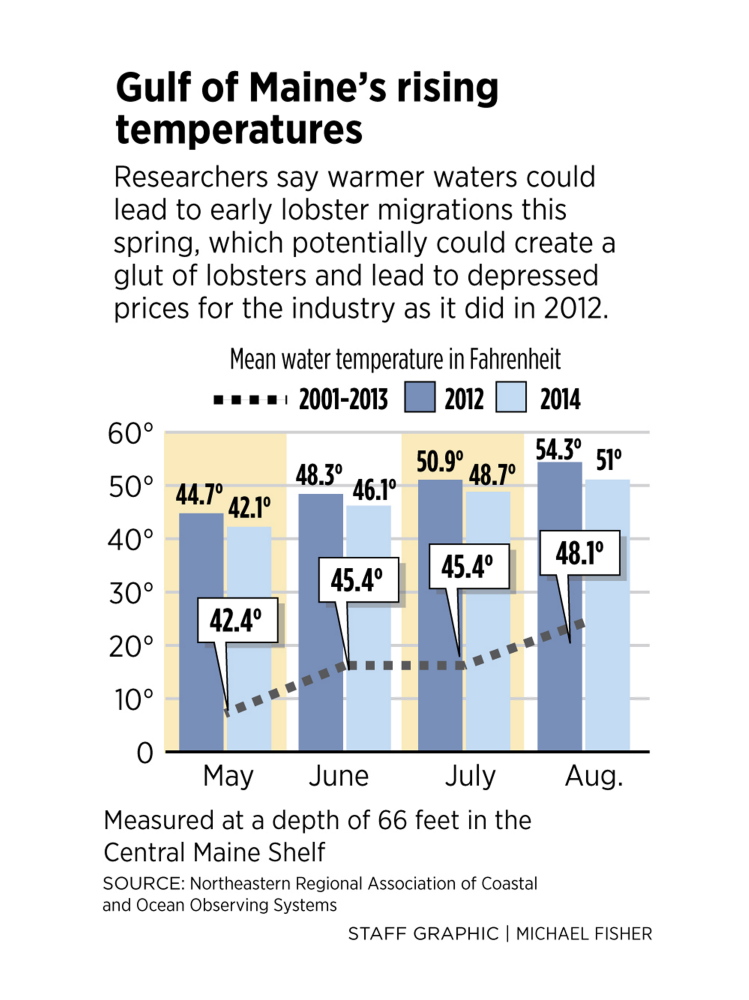So what’s the lobster forecast look like for the weekend?
Mainers will soon have an answer.
Scientists this spring will begin issuing weekly forecasts indicating when lobsters start to migrate from deep waters off the coast to state waters nearer shore where they are easier to catch. The forecasts, based on water temperatures, will help lobstermen and processors gear up for the 2015 fishing season.
The announcement was made Thursday by scientists with the Gulf of Maine Research Institute at a conference in Portland hosted by the Island Institute for fishermen and marine researchers.
Early indicators of lobster movement could help the industry prepare for the kind of conditions that occurred in 2012, when unusually high ocean temperatures prompted lobsters to shed their hard shells and migrate toward shore several weeks earlier than usual, resulting in a market glut and plummeting lobster prices.
Lobsters molt so they can grow into new, larger shells. A molted lobster, which has a soft shell, is typically called a “shedder” by Maine lobstermen.
Scientists are spotting trends now that indicate shedders will appear earlier this spring than is typical.
The current average temperature of the Gulf of Maine right now is unusually warm – 2.3 degrees Fahrenheit above the average temperature for this time of year recorded from 1982 to 2011, said Andrew Pershing, chief scientist at the gulf research institute, who is leading the forecasting program.
It would take a long stretch of unusually cold weather to bring those temperatures down to normal, he said.
The National Weather Service’s long-range forecast also calls for the Gulf of Maine to be much warmer than usual next year.
“If the forecasts play out as the models say, 2015 could look a lot like 2012,” Pershing said, while noting that forecasting temperatures so far in advance is difficult.
In 2012, lobstermen began catching shedders in April, three to six weeks earlier than usual.
Because the lobster season in Canada extends into June, lobster-processing companies in Canada were busy processing hard-shell Canadian lobsters and had no capacity to handle the spring influx of soft-shell lobsters from Maine, said David Cousens, a lobsterman from South Thomaston and president of the Maine Lobstermen’s Association. That led to lobstermen selling their catches at historic low prices just to get rid of them in a saturated market.
During a normal season, lobsters move to shore around the same time the summer tourists arrive in Maine, providing a ready market for the state’s lobster catch, said Steve Train, a lobsterman from Long Island in Casco Bay.
If forecasters could predict that lobsters are moving in sooner, he said, processors would be better prepared for the catch, and dealers and marketers would have more time to pursue alternative markets.
The research institute in Portland, with assistance from Bigelow Laboratory in East Boothbay, is leading the forecasting effort, which is being funded with $100,000 from NASA.
Nick Record, senior research scientist at Bigelow, is creating the mathematical models for the project. Several years ago, he created a forecasting system for predicting the migratory movements of right whales into the Gulf of Maine to help prevent collisions with ships.
Record said “ecosystem forecasting” is an established field, but too often the public never hears about the forecasts because they only appear in scientific papers. He said it’s helpful that the research institute has good connections with the public and the fishing industry so it can get the word out.
Record, in 2011, made a humorous video of his whale forecast, using a green screen and the typical banter of a television weather forecaster.
Pershing said there will be a dedicated site for the lobster forecast at www.gmri.org, the research institute’s website.
Send questions/comments to the editors.



Comments are no longer available on this story